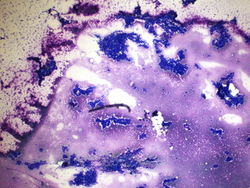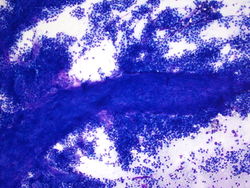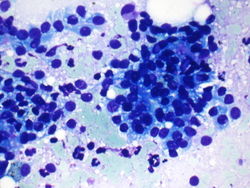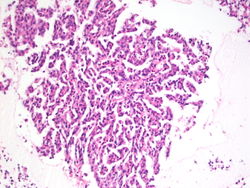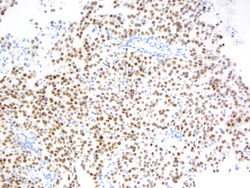Difference between revisions of "Cytologically Yours: CoW: 20131209"
| Line 23: | Line 23: | ||
<gallery heights="250px" widths="250px"> | <gallery heights="250px" widths="250px"> | ||
CytologicallyYoursCoW20131209Cytology1.jpg|4x magnification of a 4R lymph node. Groups of cohesive epithelial appearing cells can be seen on low power. Lymphoid tissue is not easily identified. | CytologicallyYoursCoW20131209Cytology1.jpg|4x magnification of a 4R lymph node. Groups of cohesive epithelial appearing cells can be seen on low power. Lymphoid tissue is not easily identified. | ||
| − | CytologicallyYoursCoW20131209Cytology2.jpg|20x magnification of a 4R lymph node. This is a cellular specimen with groups of cells along what appear to be a papillary or papillary-like structure. Single cells are also dispersed in the background. | + | CytologicallyYoursCoW20131209Cytology2.jpg|20x magnification of a 4R lymph node. This is a cellular specimen with groups of cells along what appear to be a papillary or papillary-like structure. Single cells are also dispersed in the background. The cells are haphazardly arranged. |
| − | CytologicallyYoursCoW20131209Cytology3.jpg|40x magnification of a 4R lymph node. On higher power, the nuclei appear mildly atypical and the cytoplasm is delicate and finely vacuolated. | + | CytologicallyYoursCoW20131209Cytology3.jpg|40x magnification of a 4R lymph node. On higher power, the nuclei appear mildly atypical and the cytoplasm is delicate and finely vacuolated. The nuclear contours are somewhat irregular. |
| − | CytologicallyYoursCoW20131209Cytology4.jpg|Cell block of 4R lymph node. The cytoplasm does not appear as vacuolated on alcohol fixed cell block material, but the nuclei are relatively uniform | + | CytologicallyYoursCoW20131209Cytology4.jpg|Cell block of 4R lymph node. The cytoplasm does not appear as vacuolated on alcohol fixed cell block material, but the nuclei are relatively uniform, but somewhat atypical. |
</gallery> | </gallery> | ||
| Line 36: | Line 36: | ||
====Resident Questions==== | ====Resident Questions==== | ||
| − | * <spoiler text="What | + | * <spoiler text="What are other immunohistochemical stains that would be applicable in this case?"> |
| − | * | + | ** RCC |
| − | * | + | ** CD10 |
| + | ** PAX2 | ||
| + | ** Kidney specific antigen | ||
| + | </spoiler> | ||
| + | |||
Revision as of 21:15, 14 January 2014
Contents
Clinical Summary
The patient is an 64 year old white male who presented with left sided back pain. Imaging showed a left perinephric retroperitoneal hematoma and a left renal lower pole cystic lesion with hemorrhage. Additional imaging showed numerous pulmonary lesions. A endobronchial ultrasound guided fine needle aspiration was scheduled.
Past Medical History
- Congestive heart failure
- Ventricular tachycardia
- Ischemic heart disease
Past Surgical History
- Coronary stent placement
- Implant of AICD
Clinical Plan
The concern is a primary renal malignancy with metastatic disease to lungs. An endobronchial ultrasound guided FNA is scheduled. An onsite rapid diagnosis by cytology was scheduled.
Radiology
- CT Abdomen shows a large perinephric hematoma and large low anterior structure in left lower pole suspicious for a hemorrhagic renal cell carcinoma.
- CT Chest shows multiple small lung lesions measuring up to 13x12 mm in greatest dimension.
Pathology
Cytology
Immunohistochemistry
Resident Questions
Final Diagnosis
Cytology
- Rapid diagnosis: Non-small cell carcinoma.
- Final diagnosis: Renal cell carcinoma.
Case Discussion
This is a classic case of metastatic renal cell carcinoma.
| ||||||||
